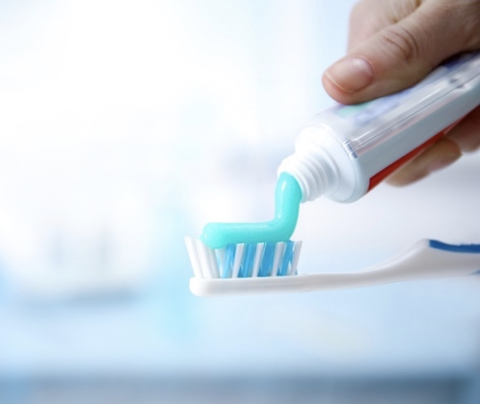 Millions of people across the world do it before going to bed every night: brush their teeth with toothpaste. Most of them give little thought to the product, but there is a lot of minty-fresh science packed into that tube. So much so, in fact, that Ames National Laboratory has partnered with the Colgate-Palmolive Company to help them improve toothpaste's main active ingredient: fluoride.
Millions of people across the world do it before going to bed every night: brush their teeth with toothpaste. Most of them give little thought to the product, but there is a lot of minty-fresh science packed into that tube. So much so, in fact, that Ames National Laboratory has partnered with the Colgate-Palmolive Company to help them improve toothpaste's main active ingredient: fluoride.
Toothpaste is the most used dental hygiene product around the world today. People use toothpaste to clean their teeth and the added fluoride helps to prevent oral diseases and tooth decay. However, toothpaste has not always pulled this level of double duty.
The first known toothpastes were developed by the ancient Egyptians around 3,000 – 5,000 BC They used dental cream made of powdered ashes from oxen hooves, eggshells, and pumice. Over time, cultures across the globe made their own versions of toothpaste, adding different abrasives, flavors, and even sweeteners. These early toothpastes were hard on teeth because of the abrasives used. They were expensive to make and did not taste good.
Toothpaste like the product we use today did not emerge until the 19th century when glycerin was added to turn tooth powder into paste. In 1873, Colgate & Co. developed the first mass-produced toothpaste, which came in a jar. Collapsible tubes soon followed. Finally in 1914 fluoride was first added to toothpaste, making it more than just a way to clean teeth.
In the 1940s, a decade-long research project showed that the addition of fluoride significantly reduced cavities in children’s teeth. These findings ultimately led to the first mass-marketed fluoride toothpaste, which was sold across the U.S. in 1956.
Today stannous fluoride, a compound of tin and fluoride (SnF2), is one of the active ingredients approved by the Food and Drug Administration for use in toothpaste under the Anticaries OTC Monograph. Fluoride helps to prevent tooth decay and plaque formation; however, SnF2 also has an antimicrobial effect that combats early gum disease.
Stannous fluoride’s antimicrobial quality depends on the tin (Sn) maintaining a +2-oxidation state, referred to as Sn(II). An oxidation state is a chemical reaction that involves electron (negatively charged particle) movement. In the Sn(II) state, the tin molecule has lost two electrons making it reactive when exposed to air.
“The problem is when you expose an aqueous tin fluoride solution to air, the tin ions will slowly oxidize over time,” explained Aaron Rossini, scientist at Ames Lab and project leader. “You can think of that like corrosion. If you had a piece of iron, over time it's going to oxidize.”
When Sn(II) is exposed to the air, it loses additional electrons and transforms into Sn(IV). However, it is difficult to determine how quickly the Sn(II) transforms into Sn(IV) because of the small amount of fluoride present. SnF2 makes up only about .05% or less of an entire tube of toothpaste. To address this challenge, Colgate-Palmolive looked to the Nuclear Magnetic Resonance (NMR) research capabilities at Ames Laboratory.
“It's very difficult to detect a tin NMR signal from such a dilute formulation like a commercial toothpaste product,” said Rossini. “That's where our expertise and knowledge come in, and the equipment we have at the Ames Lab is useful. We have the DNP solid state NMR spectrometer, which can provide sensitivity gains of 10- to 100-fold, which enables us to detect these really dilute components in the toothpaste formulation.”
As Rossini explained, dynamic nuclear polarization (DNP) enhances the capabilities of NMR, which allowed the team to collect data on the small amounts of stannous fluoride in a variety of commercially available toothpastes. The resulting data provides a better understanding of what is happening in the toothpaste at the molecular level and how the ingredients are interacting with one another.
“These are really techniques that we use to study materials for applications in electronic devices and solar cells,” said Rossini. “So, it’s exciting to adapt some of the fundamental, solid state NMR techniques that we’re developing to study a commercial healthcare product that millions of people are using in their daily lives.”
This new data is the first step towards improving the stability of stannous fluoride in toothpaste. Scientists from Ames Lab and Colgate-Palmolive will continue their partnership to deliver an improved product to consumers.
Ames National Laboratory is a U.S. Department of Energy Office of Science National Laboratory operated by Iowa State University. Ames Laboratory creates innovative materials, technologies, and energy solutions. We use our expertise, unique capabilities, and interdisciplinary collaborations to solve global problems.
Ames Laboratory is supported by the Office of Science of the U.S. Department of Energy. The Office of Science is the single largest supporter of basic research in the physical sciences in the United States and is working to address some of the most pressing challenges of our time. For more information, please visit https://energy.gov/science.
